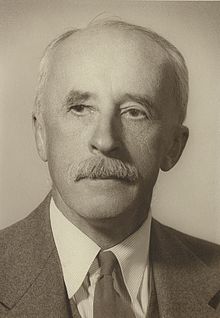Nicolas Minorsky
Nicolas Minorsky (born September 24, 1885 in Korcheva, Tver Governorate , Russian Empire , † July 31, 1970 ) was the inventor of a gyrometer.
Career
Nicolas Minorsky studied at the Nautical School in Saint Petersburg and from 1908 at the Faculty of Electrical Engineering at the University of Nancy . He then worked at the Tsar's Technical School until he received his doctorate in the field of science in 1914. From 1914 to 1917 he served in the Russian Navy . During this time he developed a gyrometer and carried out measurements of the sensitivity of the eye to detect angular velocities around 1916 . (JB Henderson had already received a secret patent for a similar device in 1907. Keith Elphinstone and Harry Egerton Wimperis had developed another similar system in 1910. ) For a year he was Adjunct Naval Attaché at the Russian Embassy in Paris.
In June 1918 he emigrated to the USA, where he was Charles P. Steinmetz's assistant for the first four years at General Electric .
According to his publications in 1922 and 1930, he dealt with the automatic steering of ships. The first attempts at servo-controlled oars were made as early as 1864. One of the problems was measuring the position of the compass needle without affecting its accuracy. His early work influenced Harold Locke Hazen (1901–1980), who reported on his servo mechanism in 1934. ( Vannevar Bush and Norbert Wiener found out about this .) From 1922 to 1923, on behalf of the Bureau of Construction and Repair of the US Navy , he examined his ship 's control system with PID control on the USS New Mexico and set up a mathematical analysis. The increased range of the ship's cannons had made accurate steering necessary. Although the attempt was successful, he had to dismantle his control again, as it displeased the team. In 1930 he sold his patent to Bendix Corporation , which had entered aeronautics the previous year . He analyzed Elmer Ambrose Sperry's system and reported on it in The Engineer in 1937 .
From 1924 to 1934 he was Professor of Electronics and Applied Physics at the University of Pennsylvania . He then went to the United States Naval Research Laboratory and worked at the David Taylor Model Basin on stabilizing ships against roll.
During the war he was an advisor to his director and became interested in non-linear problems. From 1946 he worked at the Faculty of Mechanical Engineering at Stanford University . After his retirement in 1950 he lived in southern France at the foot of the Pyrenees .
Publications
- Directional stability of automatically steered bodies. 1920 (Journal of the American Society of Naval Engineers, Volume 34, 1922, pp. 280-309)
- Introduction to Nonlinear Mechanics. 1947
- The Principles and Practice of Automatic Control. In: The Engineer. 1937, p. 322
- Introduction to non-linear mechanics. Topological methods, analytical methods, non-linear resonance, relaxation oscillations. 1947
- Nonlinear oscillations. 1962
- with Eugene Leimanis: Dynamics and nonlinear mechanics. Some recent advances in the dynamics of rigid bodies and celestial mechanics. 1958
- Nonlinear oscillations. 1962
- Theorie des oscillations. 1967
- Theory of nonlinear control systems. 1969
supporting documents
- ↑ http://www.cpdee.ufmg.br/~palhares/Minorsky.pdf
- ↑ http://ieeexplore.ieee.org/xpls/abs_all.jsp?tp=&arnumber=4392906&tag=1
| personal data | |
|---|---|
| SURNAME | Minorsky, Nicolas |
| BRIEF DESCRIPTION | Control engineer |
| DATE OF BIRTH | September 24, 1885 |
| PLACE OF BIRTH | Korcheva, Tver Governorate , Russian Empire |
| DATE OF DEATH | July 31, 1970 |
